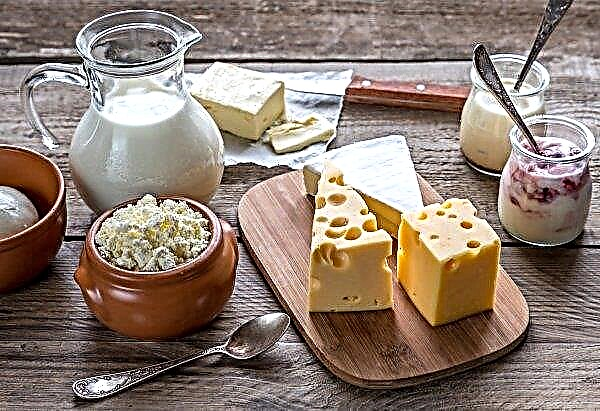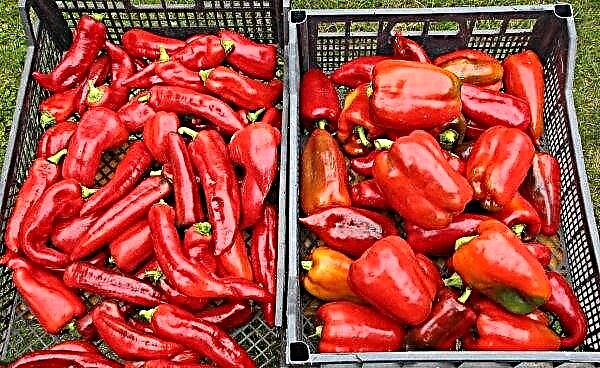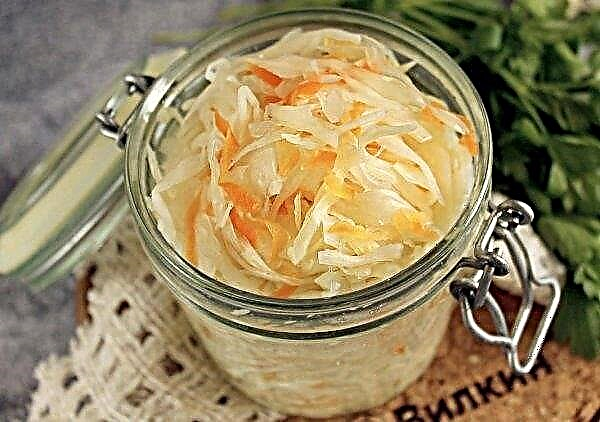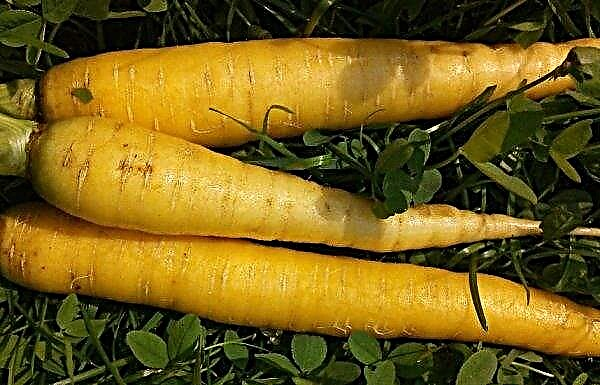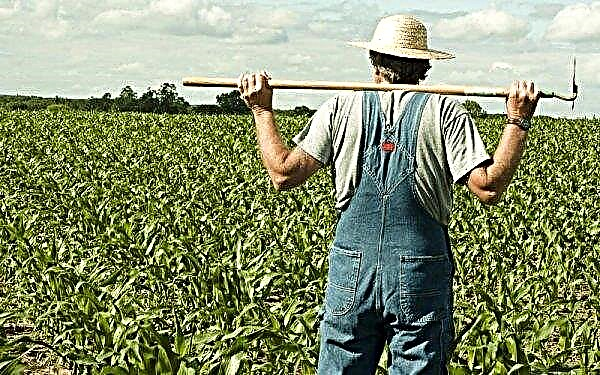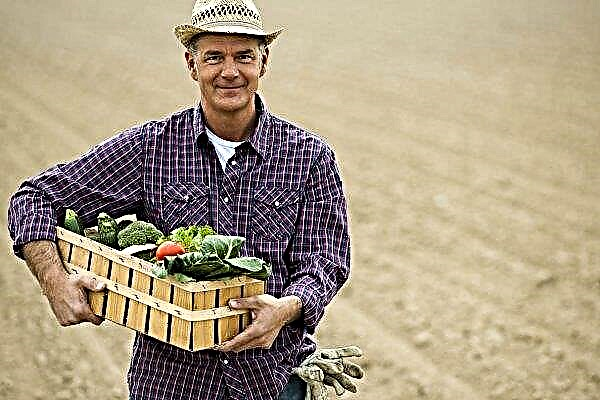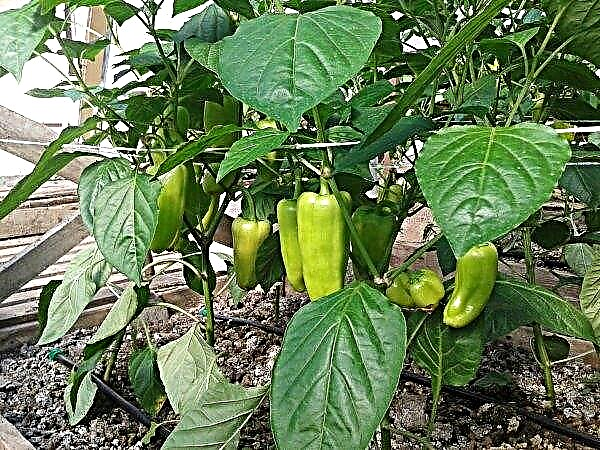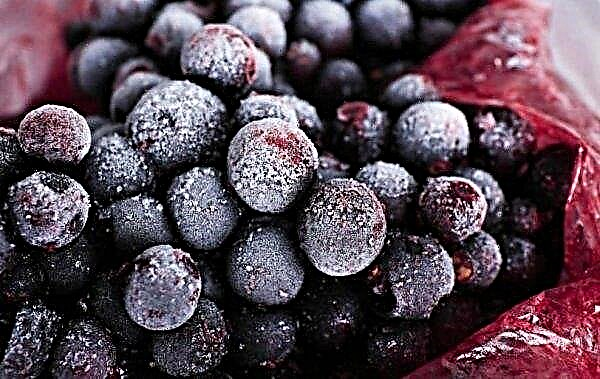In recent years, farmers began to use the method of updating potatoes by seed propagation. One of the varieties intended for sowing seeds is the Empress. Read more about the culture and methods for producing high-quality potato seed crops below.
Breed cultivation
The culture in question was bred literally a few years ago. The originator of the variety is the Russian agricultural company "Sedek". Today, this potato is in state tests and has not yet been entered in the register. The culture is not zoned, but spreads everywhere and quickly enough, due to its high adaptability to different types of soils and climate.
Did you know? It took a century to popularize potatoes in Europe, because the haters of innovations spread rumors about the toxicity of tubers, as well as the possibility of picking up leprosy or tuberculosis using them.
Botanical Description
The described variety is precocious. High adaptive ability and fast growing season allows cultivating the Empress even in regions of risky farming, with a short summer period.
Potato Description
The tubers are large and medium. Their weight varies between 70-150 g. The surface of the potatoes is leveled, smooth. On the peel, a few eyes are clearly visible. The skin color is yellow, the flesh is cream. The digestibility of tubers is average, which allows them to be used for preparing any dishes. During heat treatment, only the upper part of the tuber becomes friable. When cooking in a uniform, the peel crackes. The taste of potatoes is bright. Empress potatoes are distinguished by excellent taste and the almost regular form of tubers
Empress potatoes are distinguished by excellent taste and the almost regular form of tubers
Bush description
Plants are compact erect bushes. They occupy a relatively smaller area than other varieties of potatoes. The height of the bushes is about 80 cm. Plants form 4–6 powerful bare ribbed shoots, the underground part of which produces long lateral shoots called stolons. Potato tubers form on these sprouts. The plant has the ability to form root crops again after partial harvesting.
Important! Potato berries exude a pleasant strawberry flavor, but are extremely toxic due to the high solanine content. In this regard, with the independent collection of seeds, you need to perform all work with gloves, and then wash your hands well.
If after 70 days to clear the soil and remove the existing potatoes, by the fall will form a second crop. Foliage is pinnate, dark green, located on the shoots in a spiral. White flowers. They have the ability to self-pollination. Corolla is spike-shaped, framed by 5 petals. Shaped inflorescences are formed at the ends of the shoots. In place of flowers, fleshy green berries with a diameter of about 2 cm are formed. In the ripening phase, they acquire a greenish-white hue. Inside them contains seeds.
Ripening dates and productivity
Potatoes ripen within 55–65 days. One nest accounts for 7 to 10 tubers. Productivity is 300-400 kg / ha.
Resistance to disease
The variety is resistant to:
- scab;
- late blight;
- viral diseases.
Did you know? Before the advent of potatoes, turnips were cultivated on such a scale in Russia, and in Ukraine, cereals were the basis of nutrition.
Pros and possible disadvantages
Before deciding on the cultivation of potato seeds, you need to familiarize yourself with the pros and cons of the variety itself, as well as this method of updating planting material.
- The main advantages of the Empress:
- ability to form 2 crops in 1 nest;
- excellent taste characteristics;
- disease resistance;
- good adaptive abilities of plants;
- undemanding to the composition of the soil;
- the formation of a quality crop for 4 years;
- seeds are cheaper than seed potatoes.
- Among the shortcomings can be identified:
- the duration of the process - in the first year potato sets are formed, and only from the second year can table copies be obtained;
- potato seedlings are very demanding to care for, so this is not suitable for beginners;
- not very high productivity.
The technology of growing varieties in open ground
At the initial stage, you need to get potato sets, because you won’t be able to buy it. Only botanical seeds of the Empress potato go on sale. After purchase, the seeds are soaked for 3-4 days in a solution of "Epina" - 1 drop of the drug is added to 100 ml of water. Water is changed daily so that it does not stagnate. When the seeds hatch, they are sown in soil intended for seedlings. You can not soak the seeds, but sow them in abundantly moist soil. Sowing depth - 0.5 cm, distance between seeds - 5 cm, between rows - 8 cm. Before planting, the soil must be disinfected, having calcined in the oven for 15 minutes at a temperature of + 100 ° С. Soil moisture should be at least 50%.
You can not soak the seeds, but sow them in abundantly moist soil. Sowing depth - 0.5 cm, distance between seeds - 5 cm, between rows - 8 cm. Before planting, the soil must be disinfected, having calcined in the oven for 15 minutes at a temperature of + 100 ° С. Soil moisture should be at least 50%. After sowing, the containers are covered with polyethylene. After 2 days in several places, the film must be cut so that oxygen enters the landings. If the soil dries, it is moistened with a spray bottle. With the advent of seedlings, the film is completely removed. Within 3 weeks after the emergence of seedlings, it is possible to transplant into different containers with a diameter of 10 cm. Peat self-decomposing containers are best used. At this stage, the quality of the soil is of particular importance - it must be very loose.
After sowing, the containers are covered with polyethylene. After 2 days in several places, the film must be cut so that oxygen enters the landings. If the soil dries, it is moistened with a spray bottle. With the advent of seedlings, the film is completely removed. Within 3 weeks after the emergence of seedlings, it is possible to transplant into different containers with a diameter of 10 cm. Peat self-decomposing containers are best used. At this stage, the quality of the soil is of particular importance - it must be very loose.
Make up the soil mixture as follows:
- chernozem is placed in the bottom of the pot;
- then there is a layer of peat with the addition of coarse sand (1: 0.3);
- the top layer is constructed of sawdust.
Potato seedlings do not grow well, therefore Throughout the entire time, once a week, sprouts must be sprayed with a solution of a growth accelerator. You can use "Epin" according to the instructions. Watering is carried out every 3-4 days. Transplantation is carried out when the shoots reach a height of 15 cm and grow 5-6 true leaves.
In the open ground, the first year is planted only in the southern regions, in the rest sprouts are planted only in greenhouses, otherwise all labor will be in vain. Dive should not be earlier than the end of May - beginning of June. In greenhouses, the first-year-olds are planted at a distance of 20 cm from each other, and between the rows they maintain an interval of 40 cm. When planting in open ground, the intervals are increased by 10 cm. The holes are dug so large that the pot enters in diameter and 5-10 cm more in depth. When planting, the shoot must be deepened so that its height above the soil is 10 cm.
When planting in open ground, the intervals are increased by 10 cm. The holes are dug so large that the pot enters in diameter and 5-10 cm more in depth. When planting, the shoot must be deepened so that its height above the soil is 10 cm.
Throughout the growing season, watering is carried out on demand. Water is poured into the aisles, and not directly under the bushes. After each watering, soil loosening is carried out. 2 weeks after transplantation, the hilling is carried out. In greenhouses, it is difficult to carry out such manipulation, so it is better to pour a mixture of peat, dry manure and sand under the bushes. Hilling is carried out 2 more times with an interval of 20 days.
2 weeks after transplantation, the hilling is carried out. In greenhouses, it is difficult to carry out such manipulation, so it is better to pour a mixture of peat, dry manure and sand under the bushes. Hilling is carried out 2 more times with an interval of 20 days.
Fertilizer is applied only 2 times:
- For the first time - 20 days after transplantation. At this stage, a mullein solution is used: 2 cups of manure and 30 g of superphosphate are added to 10 liters of water.
- The second time they feed plants 4 weeks before harvesting. At this stage, a solution of wood ash is used: 800 g of ash are added per 10 l. The bushes themselves are sprayed with the composition and water the soil. This amount is enough for 1 m² of plantings.
In the fall, they start collecting potato sets. If everything is done correctly, in the upper layer of soil under the bushes there will be a large number of round potatoes. When selecting, you should carefully inspect each bush. Semi-empty roots should not be planted - it is better to leave them for processing. The goal is to use the most productive specimens in the future, and nothing will grow out of half-empty roots. After the harvest, it can not be subjected to vernalization; it will be well stored anyway.
The goal is to use the most productive specimens in the future, and nothing will grow out of half-empty roots. After the harvest, it can not be subjected to vernalization; it will be well stored anyway.
The schedule of work for 2 years when growing the Empress variety:
| First year | Second year |
| March - sowing seeds for seedlings | April - vernalization of planting material |
| April - picking seedlings in separate containers | May - landing |
| May - June - landing in open ground or in a greenhouse | June - August - care of the bushes |
| June - August - agricultural care activities | September - potato harvesting |
| September - cleaning and storage |
For another 3 years, it will be possible to obtain excellent harvests of table potatoes. Then again, you need to update the planting material through the sowing of botanical seeds.
Optimal landing location and timing
The area for planting potatoes should be well lit by the sun and be protected from the north winds. Particular attention should be paid to the location of groundwater: they should be no closer than 2 m. One of the requirements for growing potatoes is to observe crop rotation. You should not plant culture in the same place for several years in a row. If it is not possible to change the area for planting, it should be planted with siderat plants immediately after harvesting.
Such crops include:
- radish;
- linen;
- winter crops;
- cucumbers
- legumes;
- phacelia.
When the greenery grows, they mow it and dig the field, planting all the vegetation in the soil. Over the winter, it will cross and become a natural feed for the soil.
Soil type
The variety under consideration is not demanding on the quality of the soil and adapts well to any of its types, but, like any potato, bears fruit best on light sandy loamy and loamy soils. Prepare the site begin in advance, in the fall. First, deep aeration is carried out - the soil is dug to a depth of 30 cm. In the same period, 3% solution of copper sulfate is treated, and after a week organic fertilizers are applied - 20 kg per m². Instead of organics, saltpeter can be used - 6 tbsp each. l / m², or superphosphates - 200 g / m² each. After fertilizing, the soil is once again cultivated and left alone until spring. A month before planting, they again dig the soil. For digging, 10 kg of sand and peat + 200 g of superphosphate are added to each m².
Instead of organics, saltpeter can be used - 6 tbsp each. l / m², or superphosphates - 200 g / m² each. After fertilizing, the soil is once again cultivated and left alone until spring. A month before planting, they again dig the soil. For digging, 10 kg of sand and peat + 200 g of superphosphate are added to each m².
Preparing planting material
Potato sets are taken from the cellar in April and laid for springtime. The process involves keeping potatoes at a temperature of + 20 ° C in a room with very high humidity and good illumination for 30 days. The goal is to warm the potatoes and activate life processes in it.
Did you know? During the gold rush, the only product that was more expensive than gold was potatoes. It was he who was the salvation from scurvy, which was the scourge of gold miners.
During the month, you need to carefully monitor the humidity in the room: maintaining it within 90% is quite difficult, so you have to regularly spray the potatoes with water, as well as growth accelerators, which will simultaneously serve as a treatment against diseases. “Fitosporin” proved itself to be quite good in this regard - they dilute it with water at 5:10. This composition can be sprayed with potatoes every 2 weeks before planting. He can also irrigate the soil a week before planting. Throughout the time, water should be sprayed daily, as well as turn the tubers so that they evenly warm up.
This composition can be sprayed with potatoes every 2 weeks before planting. He can also irrigate the soil a week before planting. Throughout the time, water should be sprayed daily, as well as turn the tubers so that they evenly warm up.
Did you know? The first cultivators of potato are the Peruvian Indians. They began to deal with this matter 4,000 years ago and managed to produce about 200 varieties of this plant.
Landing methods and scheme
The cultivation of potatoes in the open field is divided into several types:
- Smooth - dig a hole on the bayonet of a shovel. This is the usual universal method used on all types of soils.

- Grebneva - It is used on heavy soils, the essence is the formation of embankments in rows of 15 cm in height and the placement of potatoes in them.
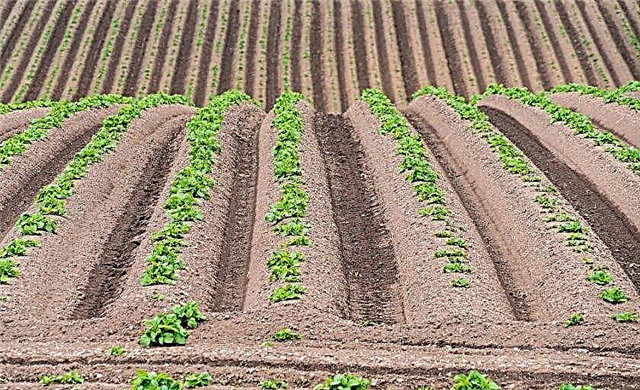
- Trench - relevant for light sandy soils, essentially the same as crest, only potatoes are not laid in elevations, but rather in the recesses in the form of trenches.

- Atypical ways - in a bag, barrel, barrow method, etc. They are used in small areas and / or in regions with poor climatic conditions.
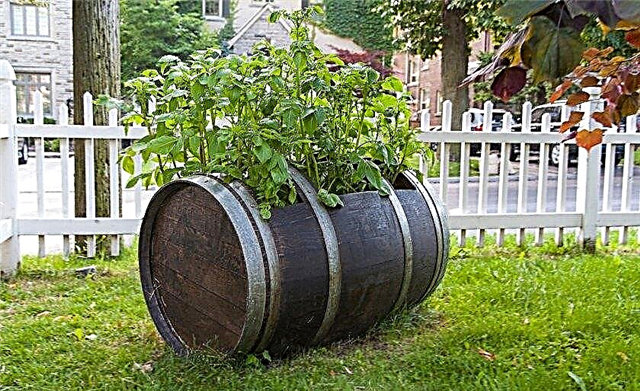
For all methods, one requirement is relevant - the plantings are located from south to north. Potato prefers lighted areas, and with this method of planting, the plant evenly receives light from all sides, which helps to increase the photosynthetic ability of the ground part.
Did you know? 100 g of potatoes contain 45% of the daily rate of ascorbic acid necessary for humans.
Yields are falling in the shade, as the photosynthesis process is inhibited, the roots do not receive enough nutrition, and the risk of spread of late blight and other fungal ailments increases. Originators recommend the following landing pattern:
Originators recommend the following landing pattern:
- 35 cm between plants;
- 80 cm between rows;
- embedment depth - 10–12 cm for light soils, 5 cm - for heavy soils.
Before planting in the recesses put at the rate of 1 potato 1 tbsp. l wood ash. Having spread the tubers, they dig in the recesses. If the landing was carried out by the standard method, then the site is leveled with a rake. Watering after planting is not carried out.
Video: planting potatoes
Further planting care
In the future, the care of the potato variety of the Empress is almost no different from that of other varieties. A number of activities are planned:
- top dressing;
- watering;
- loosening;
- mulching;
- weed removal;
- hilling;
- pest prevention.
Feeding and irrigation scheme
To get a quality table crop, you need to fertilize planting in a timely manner. Initially, top dressing is made at the time of planting. Then the plant is fed during budding and after flowering. Fertilizers are applied in parallel with irrigation or after rain. As a top dressing at the stage of budding, liquid mullein is used: it is diluted 1: 1 with water and 10 l per m² are added, per row spacing. After flowering, fertilizing is carried out with a solution of wood ash or 30 g of superphosphate are added to 10 l of water.
As a top dressing at the stage of budding, liquid mullein is used: it is diluted 1: 1 with water and 10 l per m² are added, per row spacing. After flowering, fertilizing is carried out with a solution of wood ash or 30 g of superphosphate are added to 10 l of water.
Did you know? Monarchs used different methods to popularize potatoes. For example, Marie Antoinette decorated her outfit with accessories from potato flowers, going to the ball, but the king of Prussia, Frederick II, simply issued a decree to cut off the ears of all agrarians who did not agree to grow a vegetable.
The soil should not be waterlogged, otherwise the risk of the spread of late blight is high. Standardly, humidification is carried out 3 times for the entire season, focusing on weather conditions. But with severe drought, it is carried out more often. The main thing is that the last watering was carried out no later than 3-4 weeks before harvesting. Watering is carried out for the first time after the appearance of the first shoots. Immediately after it, hilling is carried out, and then another 2 times with an interval of 20 days. The second and third watering is carried out during the formation of buds and during flowering.
Watering is carried out for the first time after the appearance of the first shoots. Immediately after it, hilling is carried out, and then another 2 times with an interval of 20 days. The second and third watering is carried out during the formation of buds and during flowering.
Pest and Disease Control
Cultivation in the open ground of early ripe varieties, including the Empress, does not require additional treatment with fungicides. It will be enough to disinfect carried out at the stage of vernalization of tuber seeds. Harvesting early varieties is carried out before the period of epidemic fungal diseases begins. Of the pests of the described variety, the Colorado potato beetle is terrible
Of the pests of the described variety, the Colorado potato beetle is terrible
The following drugs will help get rid of it:
- Inta-Vir;
- "Spark";
- "Aktara";
- "Tornado".
Dilute the funds according to the instructions. They can also be used for prevention. In addition, do not forget that these beetles are able to bury themselves in the soil and winter in it even in the most severe frosts.One of the most important methods of prevention is the cultivation of the soil at the stages of preparation for planting and during the growing season of plants.
Important! When carrying out preventive measures related to preventing the spread of the Colorado potato beetle, a new drug should be used each time, since the pest has a high ability to adapt to poisons.
Mulching and weed control
After watering, the soil in the aisles must be loosened, and then mulched with straw, mowed grass or compost. In the central regions, when mulching the soil with grass, potatoes of this variety generally do not require watering: for optimal growth and development, the plants have enough rainfall. In parallel with loosening, weeds are necessarily removed. If this is not done, the risk of contracting pests and diseases is high. In addition, weeds pull nutrients from the soil, leaving the roots of the crop without nutrition. Mulching not only helps to retain moisture in the soil, but also prevents the re-germination of weeds.
If this is not done, the risk of contracting pests and diseases is high. In addition, weeds pull nutrients from the soil, leaving the roots of the crop without nutrition. Mulching not only helps to retain moisture in the soil, but also prevents the re-germination of weeds.
Harvesting and storage
The bushes of this type of potato do not turn yellow, but remain green, therefore, it will not work to determine by the condition of the tops, whether the crop is ready for harvesting. 55 days after the emergence of seedlings, you need to dig 1-2 bushes and inspect the tubers. If they are ready for harvesting, the tops are mowed, and after 10 days they dig the entire crop. For 2-3 hours, potatoes are kept right on the beds under the sun. This process allows you to ventilate the tubers, as well as get rid of the bacteria that remained on them after staying in the soil. The resulting mini-tubers are stored in order to get their own super-elite potatoes with maximum disease resistance and the most pronounced taste next year. Then the tubers are sorted, laid out separately for processing in the near future, for seeds and for laying for storage. Then the seed potatoes are kept in the sun for a week, so that it turns green - this increases the conservation of planting material. Tubers that will be stored are poured in a single layer in a well-ventilated warm place and kept for 2-3 weeks. After that, sorting is carried out again and the potatoes are laid out in boxes or bags. Store it in a dark cool place at a temperature of +2 ... + 6 ° С and relative humidity of 60–70%.
The resulting mini-tubers are stored in order to get their own super-elite potatoes with maximum disease resistance and the most pronounced taste next year. Then the tubers are sorted, laid out separately for processing in the near future, for seeds and for laying for storage. Then the seed potatoes are kept in the sun for a week, so that it turns green - this increases the conservation of planting material. Tubers that will be stored are poured in a single layer in a well-ventilated warm place and kept for 2-3 weeks. After that, sorting is carried out again and the potatoes are laid out in boxes or bags. Store it in a dark cool place at a temperature of +2 ... + 6 ° С and relative humidity of 60–70%.
The Empress potato variety has not yet passed all the tests, but is already becoming quite popular. Only biological seeds of the plant go on sale. Although the process of growing from seeds is quite painstaking, the results of such labors are staggering.





